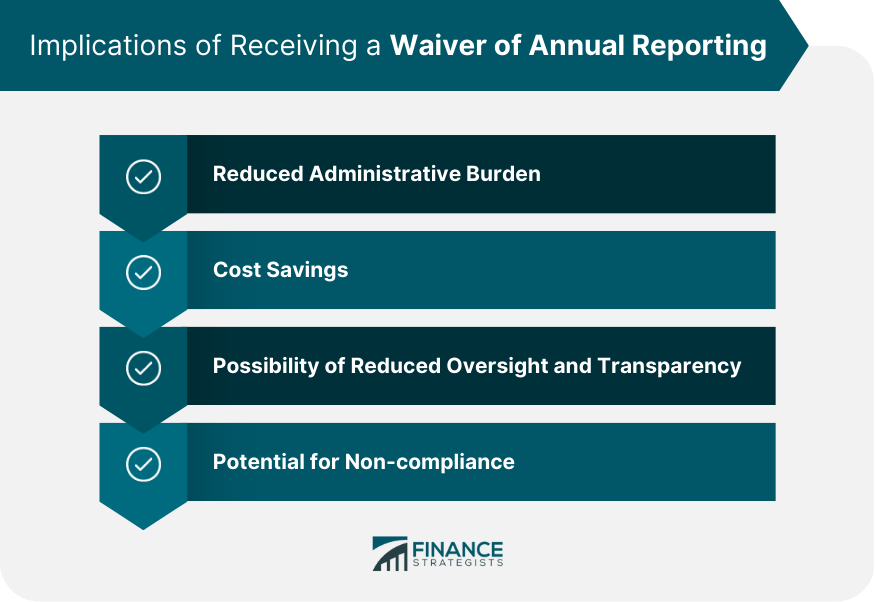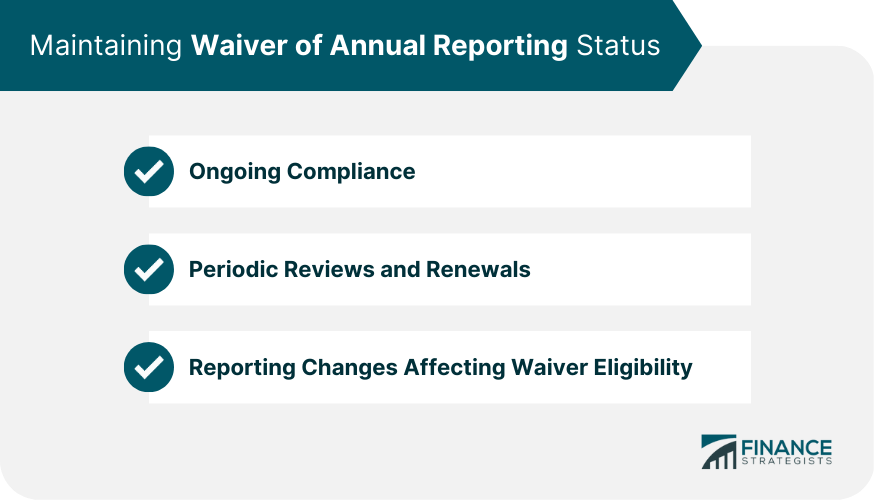A waiver of annual reporting is a permission granted by regulatory authorities to certain retirement plans, allowing them to forego submitting detailed annual reports on their financial and operational status. Annual reporting is a critical component of retirement plan administration, providing transparency and accountability to plan participants and regulators. These reports offer insights into the plan's financial stability, investment performance, and compliance with applicable laws and regulations. Some retirement plans may request a waiver of annual reporting due to the administrative burden and cost associated with preparing and submitting these reports. Obtaining a waiver can lead to significant savings in time and resources, provided the plan meets specific eligibility criteria. Not all retirement plans are eligible for a waiver of annual reporting. Generally, small plans or plans with a limited number of participants may be more likely to qualify for a waiver, depending on the specific regulatory environment. Retirement plans with fewer participants or assets may be eligible for a waiver, as they represent a lower risk to the overall retirement system. The exact threshold for size and participant count may vary by jurisdiction and regulatory authority. Plans requesting a waiver must demonstrate financial stability and solvency, ensuring that they can meet their obligations to plan participants without requiring additional oversight from regulators. Retirement plans seeking a waiver must have a strong history of compliance with all applicable laws and regulations. This includes timely submission of required reports, maintaining accurate records, and adhering to investment guidelines. To apply for a waiver, retirement plans must provide the following documentation: Plan Documents and Amendments: Copies of the plan's governing documents and any subsequent amendments. Financial Statements and Audit Reports: Audited financial statements for the most recent fiscal year, as well as any relevant audit reports. Compliance Certificates: Certificates demonstrating compliance with relevant laws and regulations. The submission process for waiver applications may vary by jurisdiction and regulatory authority, and may include options for online or paper submission. Be sure to verify the specific requirements and deadlines for your plan's jurisdiction. Some jurisdictions may charge a fee for processing waiver applications, while others may offer fee waivers for certain types of retirement plans. Research your plan's specific situation to determine whether a fee applies and if a waiver is available. The review and approval process for waiver applications is typically handled by the regulatory authorities responsible for overseeing retirement plans in your jurisdiction. This may include national or state-level agencies. Regulatory authorities will evaluate waiver applications based on the plan's eligibility criteria, including the size of the plan, the number of participants, financial stability, and compliance history. The timeline for receiving a decision on a waiver application may vary by jurisdiction and regulatory authority. It is essential to submit your application well in advance of the annual reporting deadline to ensure a timely decision. Regulatory authorities will communicate their decision on waiver applications through written correspondence, which may be delivered electronically or by mail. Be sure to maintain accurate records of all correspondence related to your waiver application. Obtaining a waiver of annual reporting can significantly reduce the administrative burden on retirement plan administrators, freeing up time and resources for other important tasks. In addition to saving time, a waiver of annual reporting can also result in cost savings for retirement plans, as the expenses associated with preparing and submitting annual reports can be substantial. While a waiver of annual reporting can offer benefits, it may also lead to reduced oversight and transparency for the retirement plan. Participants and regulators may have limited access to information about the plan's financial health and operations. Plans with a waiver of annual reporting must remain vigilant about maintaining compliance with all applicable laws and regulations. The reduced scrutiny may lead to accidental non-compliance, which could result in penalties or other consequences. Even with a waiver of annual reporting, retirement plans must continue to adhere to all other compliance requirements, including maintaining accurate records, following investment guidelines, and submitting any other required reports. Regulatory authorities may periodically review retirement plans with a waiver of annual reporting to ensure continued eligibility. Plans may also be required to renew their waiver status on a regular basis, depending on the specific regulations in their jurisdiction. If a retirement plan experiences changes that could affect its waiver eligibility, such as a significant increase in assets or participants, the plan administrator must notify the relevant regulatory authority and potentially submit updated documentation. Understanding the waiver of annual reporting process is essential for retirement plan administrators seeking to reduce the administrative burden and costs associated with annual reporting while maintaining compliance with applicable laws and regulations. While obtaining a waiver of annual reporting can offer significant benefits, including cost savings and reduced administrative tasks, it also comes with potential risks, such as reduced oversight and transparency. Plan administrators must carefully weigh these factors when considering whether to pursue a waiver. Regardless of waiver status, retirement plans must remain vigilant in maintaining compliance with all applicable regulations and monitoring their financial health to ensure the continued well-being of plan participants. Regular reviews and updates to plan documents and procedures are essential for ensuring ongoing compliance and stability.What Is a Waiver of Annual Reporting?
Eligibility Criteria for Waivers of Annual Reporting
Types of Retirement Plans Eligible
Size of Plan and Participant Count
Financial Stability and Solvency
Compliance With Regulatory Requirements
Application Process for Waivers of Annual Reporting
Documentation Required
Submission Process
Application Fees and Waivers
Review and Approval Process
Regulatory Authorities Involved
Evaluation Criteria
Timeline for Decision
Communication of Decision
Implications of Receiving a Waiver of Annual Reporting
Reduced Administrative Burden
Cost Savings
Potential Risks and Consequences
Reduced Oversight and Transparency
Potential for Non-compliance

Maintaining Waiver Status
Ongoing Compliance
Periodic Reviews and Renewals
Reporting Changes Affecting Waiver Eligibility

Conclusion
Waiver of Annual Reporting FAQs
A waiver of annual reporting is an option that allows plan sponsors to avoid filing certain annual reports with the government under certain circumstances.
The most common annual reports that can be waived are the Form 5500 and the Summary Annual Report (SAR).
A plan sponsor can request a waiver of annual reporting if the plan meets certain conditions, such as having fewer than 100 participants, being a certain type of plan, or meeting certain other requirements.
To request a waiver of annual reporting, the plan sponsor must file a Form 5500-SF or a Form 5500-EZ and check the appropriate box indicating that a waiver is being requested. The plan sponsor must also provide any other required information or documentation.
Yes, there are some risks and drawbacks to waiving an annual report. For example, waiving the Form 5500 could result in the plan losing its tax-qualified status and becoming subject to penalties and fees. Additionally, participants may not be fully informed about the plan's provisions and could miss out on certain benefits or opportunities.
True Tamplin is a published author, public speaker, CEO of UpDigital, and founder of Finance Strategists.
True is a Certified Educator in Personal Finance (CEPF®), author of The Handy Financial Ratios Guide, a member of the Society for Advancing Business Editing and Writing, contributes to his financial education site, Finance Strategists, and has spoken to various financial communities such as the CFA Institute, as well as university students like his Alma mater, Biola University, where he received a bachelor of science in business and data analytics.
To learn more about True, visit his personal website or view his author profiles on Amazon, Nasdaq and Forbes.













